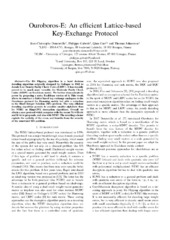| dc.contributor.author | Deneuville, Jean-Christophe | |
| dc.contributor.author | Gaborit, Philippe | |
| dc.contributor.author | Guo, Qian | |
| dc.contributor.author | Johansson, Thomas | |
| dc.date.accessioned | 2020-07-03T08:56:54Z | |
| dc.date.available | 2020-07-03T08:56:54Z | |
| dc.date.issued | 2018 | |
| dc.Published | Deneuville, Gaborit, Guo Q, Johansson T. Ouroboros-E: An efficient Lattice-based Key-Exchange Protocol. IEEE International Symposium on Information Theory. Proceedings. 2018;1450-1454 | eng |
| dc.identifier.issn | 2157-8095 | en_US |
| dc.identifier.issn | 2157-8117 | en_US |
| dc.identifier.uri | https://hdl.handle.net/1956/23301 | |
| dc.description.abstract | The Bit Flipping algorithm is a hard decision decoding algorithm originally designed by Gallager in 1962 to decode Low Density Parity Check Codes (LDPC). It has recently proved to be much more versatile, for Moderate Parity Check Codes (MDPC) or Euclidean metric. We further demonstrate its power by proposing a noisy Euclidean version of it. This tweak allows to construct a lattice based key exchange analogous to the Ouroboros protocol for Hamming metric but with a reduction to the Short Integer Solution (SIS) problem. The very efficient decoding algorithm permits to consider smaller alphabets than for NTRU or Ring-LWE decryption algorithms. Overall we obtain a new protocol which competes with the recent NEWHOPE and Kyber proposals, and also with NTRU. The resulting scheme exploits the cyclicity of the error, and benefits from the security of the renowned SIS problem. | en_US |
| dc.language.iso | eng | eng |
| dc.publisher | IEEE | en_US |
| dc.title | Ouroboros-E: An efficient Lattice-based Key-Exchange Protocol | en_US |
| dc.type | Peer reviewed | |
| dc.type | Journal article | |
| dc.date.updated | 2020-02-12T06:20:27Z | |
| dc.description.version | acceptedVersion | en_US |
| dc.rights.holder | Copyright 2018 IEEE. Personal use of this material is permitted. Permission from IEEE must be obtained for all other uses, in any current or future media, including reprinting/republishing this material for advertising or promotional purposes, creating new collective works, for resale or redistribution to servers or lists, or reuse of any copyrighted component of this work in other works. | en_US |
| dc.identifier.doi | https://doi.org/10.1109/isit.2018.8437940 | |
| dc.identifier.cristin | 1646707 | |
| dc.source.journal | IEEE International Symposium on Information Theory. Proceedings | |
| dc.relation.project | Norges forskningsråd: 247742 | |
